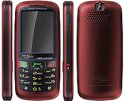Linux smartphone offers Voice Call Continuity
Aug 21, 2007 — by LinuxDevices Staff — from the LinuxDevices Archive — 1 views Linux smartphone pioneer E28 says one of its handsets supports VCC 7.0 (voice call continuity) when used with infrastructure equipment from NewStep Networks. The Linux-based E2832 handset is said to have completed interoperability testing with NewStep's Converged Services Node (CSN) equipment for enterprise and carrier… networks.
Linux smartphone pioneer E28 says one of its handsets supports VCC 7.0 (voice call continuity) when used with infrastructure equipment from NewStep Networks. The Linux-based E2832 handset is said to have completed interoperability testing with NewStep's Converged Services Node (CSN) equipment for enterprise and carrier… networks.
VCC 7.0 is the most recent iteration of a 3rd Generation Partnership Project (3GPP) specification that appears to define a type of IMS server able to move in-progress calls between packet-switched IMS (Internet multimedia subsystem) networks and circuit-switched networks like the PSTN (public switched telephone network) and older cellular networks. The VCC spec defines services such as number unification across multiple phones and networks, call hand-off between devices and/or networks, unified voicemail, and a whole range of other futuristic features.
E28 is a Shanghai-based startup founded by Motorola's former head of Asian operations, Roger Kung. The company is best known for having shipped the first Linux-based smartphone, the e2800, back in mid-2003.
Since then, E28 has shipped several generations of Linux-based smartphones and smartphone reference designs, with a recent focus on WiFi-enabled dual-mode phones and FMC (fixed-mobile convergence). It previously touted interoperability with FMC-enabled infrastructure equipment from Bridgeport Networks.
In its latest announcement, E28 said it's E2832 phone design has been tested interoperable with two VCC-enabled IMS servers from NewStep. These include the 30,000-user CSN 30 targeting enterprises and small carriers, as well as the million-user CSN 1000 server meant for larger carriers.
The larger IMS server is “currently in active service in major North American carrier networks,” NewStep said. Meanwhile, E28 continues to keep a U.S. office in the Chicago area. Thus, it seems possible that the E2832 is under consideration for possible Stateside distribution.
The e2832
 The E2832 (shown at the right) is a candybar-shaped, quad-based GSM phone with integrated 802.11b/g radio. It has a 2.2-inch QVGA (320×240) touchscreen, and also has a normal keypad interface. As a Linux-based phone, it offers unlimited carrier customizability, and also supports third-party applications compliant with Java J2ME MIDP 2.0, CLDC 1.1. E28 notes that the E2832 also supports data streaming features such as IPTV, MP3, and video recording and playback.
The E2832 (shown at the right) is a candybar-shaped, quad-based GSM phone with integrated 802.11b/g radio. It has a 2.2-inch QVGA (320×240) touchscreen, and also has a normal keypad interface. As a Linux-based phone, it offers unlimited carrier customizability, and also supports third-party applications compliant with Java J2ME MIDP 2.0, CLDC 1.1. E28 notes that the E2832 also supports data streaming features such as IPTV, MP3, and video recording and playback.
The E2832 is based on a TI OMAP730 SoC (system-on-chip), a highly integrated part with three cores. These include a 200MHz ARM926 application processor, together with an ARM7/DSP baseband processor.

TI's OMAP730 is a single-chip mobile phone chipset
(Click to enlarge)
The relatively inexpensive E2832 has 32MB of RAM and 32MB of flash, expandable via a MicroSD slot. Other features include:
- Mini-USB 1.1 client port
- “Phase 2” small 64K 16x 3V SIM card
- 40-chord polyphonic ringtones, MP3, AMR
- Mono speaker; ear-piece; stereo headset
- 960mAh battery
- 4.4 x 2 x 0.5 inches (112 x 50 x 12.5)
A few touted features of the E2832's Linux-based OS include:
- American English, Simplified Chinese, or Traditional Chinese
- QWERTY soft keyboard with next-word association
- Handwriting recognition
- Dial-pad auto-complete
- PDA only mode (for airplanes)
E28 CEO Roger Kung stated, “E28 focuses on the development of mass market FMC smart phones and [our] E2832 offers mobile consumers 'must have' design and 'must do' compelling features.”
Craig Gosselin, CMO at NewStep, added, “Our work with E28 now gives customers the choice of deploying flexible open source VCC clients, in addition to the numerous other dual-mode client handsets that we have tested for interoperability.”
Availability
The E2832 appears to be one of six ready-to-manufacture designs available from E28. NewStep's CSN 30 and CSN 1000 also appear to be available now; an entertaining video demo of the equipment's capabilities can be found here.
Meanwhile, Motorola's Linux-based RAZR2 V8 appears set to debut soon in New York, probably via T-Mobile. It will almost certainly be the first Linux-based phone to receive wide U.S. distribution. An early review of a non-U.S. V8 can be found here.
This article was originally published on LinuxDevices.com and has been donated to the open source community by QuinStreet Inc. Please visit LinuxToday.com for up-to-date news and articles about Linux and open source.